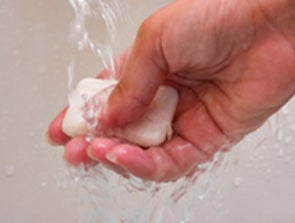Study: Chemical used in hand soaps may impair muscle function
A widely used antibacterial chemical found in hand soaps and other personal care products hinders muscle contractions at a cellular level, reduces muscular strength in mice and slows swimming in fish, according to researchers at the University of Colorado School of Medicine and the University of California, Davis. The findings appear online in the Proceedings of the National Academy of Sciences of the United States of America.
"It's somewhat disconcerting to see this compound so prevalent in so many everyday products knowing that it can have such a negative effect on cardiac and skeletal muscle function," said CU School of Medicine Professor Kurt Beam, Ph.D., Department of Physiology and Biophysics. Beam and CU School of Medicine Assistant Professor Roger Bannister, Ph.D., Department of Cardiology, are co-authors of the study.
In 1998, the U.S. Environmental Protection Agency estimated that more than 1 million pounds of triclosan are produced in the United States annually and found the chemical in waterways and aquatic organisms ranging from algae to fish to dolphins, as well as in human urine, blood and breast milk.
Triclosan is found in everyday antibacterial personal care products including hand soap, deodorant, mouthwash, toothpaste, bedding, carpets, toys and trash bags.
"The commonality between cardiac and skeletal muscle is the keystone protein that transduce the electrical signals into muscle contraction," explained Bannister, who was a post-doctoral researcher in Beam's lab at the time of the study. "Our work indicates that triclosan inhibits these proteins from engaging muscle contraction."
The experiments performed by the investigators used doses of triclosan similar to those that people and animals might be exposed to during everyday life. The investigators then evaluated the effects of the additive on muscle activity.
Triclosan was found to impair the ability of isolated heart muscle cells and skeletal muscle fibers to contract in "test tube" experiments. The team targeted its evaluation on the effects triclosan had on the molecular channels in muscle cells that control the flow of calcium ions, creating muscle contractions.
Normally, electrical stimulation- "excitation"- of isolated muscle fibers under experimental conditions evokes a muscle contraction, a phenomenon which is known as "excitation-contraction coupling" (ECC). ECC is the fundamental basis of any muscle movement, including heartbeats. But, in the presence of triclosan the communication was impaired between the two proteins that function as calcium channels, causing cardiac and skeletal muscle failure.
The team also found that triclosan impairs heart and skeletal contractility in living animals. Within 20 minutes of exposure to the chemical, anesthetized mice had up to a 25-percent reduction in heart function. And, after just a single dose of triclosan, the grip strength of the mice was reduced by 18 percent for up to 60 minutes. Grip strength is a common measure of mouse limb strength, used to investigate the effects of drugs and neuromuscular disorders.
"Our findings regarding the effects of triclosan on cardiac and skeletal muscle excitability are fairly conclusive," Beam said.
Added Bannister, "What needs to be determined next is how much triclosan gets into the tissues of people and what the toxicity levels truly are. It will also be important to determine the extent to which it accumulates in fish and other aquatic animals."
Fathead minnows, often used as a model organism for studying the potential impacts of aquatic pollutants, were also part of the study. After seven days of exposure to triclosan in the water, the fish exhibited significantly reduced swimming activity compared to the controls during both normal swimming and swim tests designed to imitate fish being threatened by a predator.
Previous UC Davis research had linked triclosan to other potentially harmful health effects, including disruption of reproductive hormone activity and of cell signaling to the brain.
Triclosan was developed more than 40 years ago to prevent bacterial infections in hospitals. Since then, it has become prevalent in household antibacterial products. But, according to the U.S. Food and Drug Administration (FDA), with the exception of its use in some toothpastes to prevent gingivitis, there is no evidence of other health benefits from triclosan, nor that antibacterial soaps are more effective than washing with soap and water. There also is concern among experts that resistant strains of bacteria could be developed due to the overuse of antibacterial products.
The chemical structure of triclosan resembles other toxic chemicals in the environment, sparking the FDA and U.S. Environmental Protection Agency to conduct new risk assessments. Pointing to their study outcomes, the researchers are calling for greater restrictions on the chemical to safeguard against potential health risks.
"One concern is the direct application of this product," said Beam, "when, for example, a person brushes their teeth or uses a soap dispenser in a washroom. This research suggests that we may need to rethink triclosan's presence in a lot of these marketed products. Besides the possibility that it may affect human health, there is also a danger that its constant discharge into the water may negatively affect fish and other aquatic organisms."
"The findings concern us in a much broader context," concluded Bannister. "There are many unnecessary additives out there, not only in our hygiene products but also in our food. Triclosan is just one example and is almost certainly not the worst one of the lot."
A copy of the study, titled "Triclosan impairs excitation-contraction coupling and Ca2+ dynamics in striated muscle," can be requested by e-mailing PNASNews@nas.edu.
The research was funded by the National Institutes of Health, the Muscular Dystrophy Association and the J.B. Johnson Foundation.
Other authors of the study are Isaac Pessah, principal investigator, professor and chair of the Department of Molecular Biosciences in the UC Davis School of Veterinary Medicine; Gennady Cherednichenko, Rui Zhang, Erika Fritsch, Wei Feng and Genaro Barrientos of the UC Davis School of Veterinary Medicine; Nipavan Chiamvimonvat, Valeriy Timofeyev and Ning Li of the UC Davis Division of Cardiovascular Medicine; Bruce Hammock and Nils Schebb of the UC Davis Department of Entomology.


